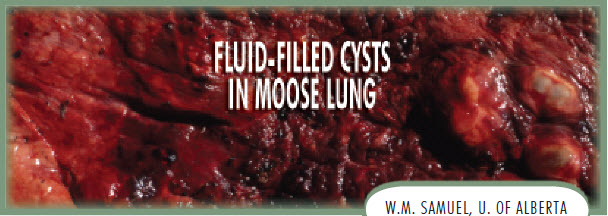Hydatid Disease
| Question | Answer |
|---|
| Example |

|
| Can I still use the animal |
Yes - take safety precautions
|
| Commonly infected wildlife |
Canines, Cervids |
| Is this animal infected |
- Adult worms live and grow in infected dog and wild canine (wolf and coyote) intestines
- Infected cervids often have large fluidfilled cysts in lungs or liver – these cysts are NOT infectious to people
|
| Can I get it |
Yes
- Dogs and wild canines eat cysts of cervid lungs and liver, and worms mature
- The worms release eggs in dog and wild canine feces, and eggs stick to their fur
- The shed eggs can infect people
|
| How bad can it get |

Gets worse with time and depends on organ affected
|
| How can I protect myself and others |
- When handling live canines, their feces, pelts or carcasses:
- Wear disposable gloves
- Practice good hygiene
- WASH YOUR HANDS
- Disinfect your work space
|
| Symptoms in humans |
- Severity of symptoms depends on if and where the juvenile worms form cysts:
- Brain – death
- Lungs – breathing difficulties
- Abdomen – liver damage
- Consult your doctor if you have health concerns after handling wolf or coyote carcasses
|
| Is it safe for pets |
No
- Cysts found in cervids can infect pet dogs
- Once infected, pet dogs can be a source of infection to you and your family
DO NOT ALLOW dogs access to lungs and liver from cervids
|
| What causes it |
- The tapeworms Echinococcus granulosus and Echinococcus multilocularis
|


